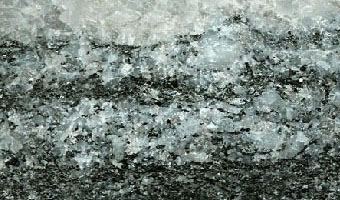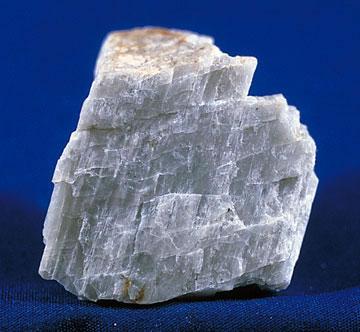|
Quartz Diorite
Quartz diorite is an igneous, plutonic ( intrusive) rock, of felsic composition, with phaneritic texture. Feldspar is present as plagioclase (typically oligoclase or andesine) with 10% or less potassium feldspar. Quartz is present at between 5 and 20% of the rock. Biotite, amphiboles and pyroxenes are common dark accessory minerals. Quartz diorite occurs in association with other granitic rock such as granodiorite, and with volcanic A volcano is commonly defined as a vent or fissure in the crust of a planetary-mass object, such as Earth, that allows hot lava, volcanic ash, and gases to escape from a magma chamber below the surface. On Earth, volcanoes are most often fo ... rock. In western North America a "quartz diorite line" occurs; west of this line, the dominant granitic rock is quartz diorite. References Definition with images Plutonic rocks ja:閃緑岩#石英閃緑岩 {{igneous-rock-stub ... [...More Info...] [...Related Items...] OR: [Wikipedia] [Google] [Baidu] |
Andesine
Andesine is a silicate mineral, a member of the plagioclase feldspar solid solution series. Its chemical formula is ( Ca, Na)( Al, Si)4 O8, where Ca/(Ca + Na) (% anorthite) is between 30 and 50%. The formula may be written as Na0.7-0.5Ca0.3-0.5Al1.3-1.5Si2.7-2.5O8. The plagioclase feldspars are a continuous solid solution series and as such the accurate identification of individual members requires detailed optical study, chemical analysis or density measurements. Refractive indices and specific gravity increase directly with calcium content.Klein, Cornelis, and Cornelius S. Hurlbut, Jr., ''Manual of Mineralogy,'' Wiley, 20th ed. 1985, p. 455 It is sometimes used as a gemstone. Name and discovery Andesine was first described in 1841 for an occurrence in the Marmato mine, Marmato, Cauca, Chocó Department, Colombia. The name is for the Andes due to its abundance in the andesite lavas in those mountains. In the early 2000s, red and green gemstones began to be marketed under th ... [...More Info...] [...Related Items...] OR: [Wikipedia] [Google] [Baidu] |
Volcanic
A volcano is commonly defined as a vent or fissure in the crust of a planetary-mass object, such as Earth, that allows hot lava, volcanic ash, and gases to escape from a magma chamber below the surface. On Earth, volcanoes are most often found where tectonic plates are diverging or converging, and because most of Earth's plate boundaries are underwater, most volcanoes are found underwater. For example, a mid-ocean ridge, such as the Mid-Atlantic Ridge, has volcanoes caused by divergent tectonic plates whereas the Pacific Ring of Fire has volcanoes caused by convergent tectonic plates. Volcanoes resulting from divergent tectonic activity are usually non-explosive whereas those resulting from convergent tectonic activity cause violent eruptions."Mid-ocean ridge tectonics, volcanism and geomorphology." Geology 26, no. 455 (2001): 458. https://macdonald.faculty.geol.ucsb.edu/papers/Macdonald%20Mid-Ocean%20Ridge%20Tectonics.pdf Volcanoes can also form where there is stretching a ... [...More Info...] [...Related Items...] OR: [Wikipedia] [Google] [Baidu] |
Granodiorite
Granodiorite ( ) is a coarse-grained (phaneritic) intrusive igneous rock similar to granite, but containing more plagioclase feldspar than orthoclase feldspar. The term banatite is sometimes used informally for various rocks ranging from granite to diorite, including granodiorite. The term ''granodiorite'' was first used by George F. Becker, G. F. Becker (1893) to describe granitic rocks in the Sierra Nevada, United States. Composition According to the QAPF diagram, granodiorite has a greater than 20% quartz by volume, and between 65% and 90% of the feldspar is plagioclase. A greater amount of plagioclase would designate the rock as tonalite. Granodiorite is felsic to intermediate composition, intermediate in composition. It is the Intrusive rock, intrusive igneous equivalent of the extrusive igneous dacite. It contains a large amount of sodium (Na) and calcium (Ca) rich plagioclase, potassium feldspar, quartz, and minor amounts of muscovite mica as the lighter colored miner ... [...More Info...] [...Related Items...] OR: [Wikipedia] [Google] [Baidu] |
Pyroxene
The pyroxenes (commonly abbreviated Px) are a group of important rock-forming inosilicate minerals found in many igneous and metamorphic rocks. Pyroxenes have the general formula , where X represents ions of calcium (Ca), sodium (Na), iron (Fe(II)) or magnesium (Mg) and more rarely zinc, manganese or lithium, and Y represents ions of smaller size, such as chromium (Cr), aluminium (Al), magnesium (Mg), cobalt (Co), manganese (Mn), scandium (Sc), titanium (Ti), vanadium (V) or even iron (Fe(II) or Fe(III)). Although aluminium substitutes extensively for silicon in silicates such as feldspars and amphiboles, the substitution occurs only to a limited extent in most pyroxenes. They share a common structure consisting of single chains of silica tetrahedra. Pyroxenes that crystallize in the monoclinic system are known as clinopyroxenes and those that crystallize in the orthorhombic system are known as orthopyroxenes. The name ''pyroxene'' is derived from the Ancient Greek w ... [...More Info...] [...Related Items...] OR: [Wikipedia] [Google] [Baidu] |
Amphibole
Amphibole ( ) is a group of inosilicate minerals, forming prism or needlelike crystals, composed of double chain tetrahedra, linked at the vertices and generally containing ions of iron and/or magnesium in their structures. Its IMA symbol is Amp. Amphiboles can be green, black, colorless, white, yellow, blue, or brown. The International Mineralogical Association currently classifies amphiboles as a mineral supergroup, within which are two groups and several subgroups. Mineralogy Amphiboles crystallize into two crystal systems, monoclinic and orthorhombic. In chemical composition and general characteristics they are similar to the pyroxenes. The chief differences from pyroxenes are that (i) amphiboles contain essential hydroxyl (OH) or halogen (F, Cl) and (ii) the basic structure is a double chain of tetrahedra (as opposed to the single chain structure of pyroxene). Most apparent, in hand specimens, is that amphiboles form oblique cleavage planes (at around 120 degrees), wh ... [...More Info...] [...Related Items...] OR: [Wikipedia] [Google] [Baidu] |
Biotite
Biotite is a common group of phyllosilicate minerals within the mica group, with the approximate chemical formula . It is primarily a solid-solution series between the iron- endmember annite, and the magnesium-endmember phlogopite; more aluminous end-members include siderophyllite and eastonite. Biotite was regarded as a mineral ''species'' by the International Mineralogical Association until 1998, when its status was changed to a mineral ''group''. The term ''biotite'' is still used to describe unanalysed dark micas in the field. Biotite was named by J.F.L. Hausmann in 1847 in honor of the French physicist Jean-Baptiste Biot, who performed early research into the many optical properties of mica. Members of the biotite group are sheet silicates. Iron, magnesium, aluminium, silicon, oxygen, and hydrogen form sheets that are weakly bound together by potassium ions. The term "iron mica" is sometimes used for iron-rich biotite, but the term also refers to a flaky micace ... [...More Info...] [...Related Items...] OR: [Wikipedia] [Google] [Baidu] |
Quartz
Quartz is a hard, crystalline mineral composed of silica (silicon dioxide). The Atom, atoms are linked in a continuous framework of SiO4 silicon–oxygen Tetrahedral molecular geometry, tetrahedra, with each oxygen being shared between two tetrahedra, giving an overall chemical formula of Silicon dioxide, SiO2. Quartz is, therefore, classified structurally as a Silicate mineral#Tectosilicates, framework silicate mineral and compositionally as an oxide mineral. Quartz is the second most abundant mineral in Earth's continental crust, behind feldspar. Quartz exists in two forms, the normal α-quartz and the high-temperature β-quartz, both of which are chiral. The transformation from α-quartz to β-quartz takes place abruptly at . Since the transformation is accompanied by a significant change in volume, it can easily induce microfracturing of ceramics or rocks passing through this temperature threshold. There are many different varieties of quartz, several of which are classifi ... [...More Info...] [...Related Items...] OR: [Wikipedia] [Google] [Baidu] |
Oligoclase
Oligoclase is a rock-forming mineral belonging to the plagioclase feldspars. In chemical composition and in its crystallographic and physical characters it is intermediate between albite ( Na Al Si3 O8) and anorthite ( CaAl2Si2O8). The albite:anorthite molar ratio of oligoclase ranges from 90:10 to 70:30. Oligoclase is a high sodium feldspar crystallizing in the triclinic system. The Mohs hardness is 6 to 6.5 and the specific gravity is 2.64 to 2.66. The refractive indices are: nα = 1.533–1.543, nβ = 1.537–1.548, and nγ = 1.542–1.552. In color it is usually white, with shades of grey, green, or red. Oligoclase is a common mineral in the more silica-rich varieties of igneous rock and in many metamorphic rocks. Name and discovery The name oligoclase was given by August Breithaupt in 1826 from the , little, and , to break, because the mineral was thought to have a less perfect cleavage than albite. It had previously been recognized as a distinct species by J. J. Berzel ... [...More Info...] [...Related Items...] OR: [Wikipedia] [Google] [Baidu] |
Igneous Rock
Igneous rock ( ), or magmatic rock, is one of the three main rock types, the others being sedimentary and metamorphic. Igneous rocks are formed through the cooling and solidification of magma or lava. The magma can be derived from partial melts of existing rocks in either a planet's mantle or crust. Typically, the melting is caused by one or more of three processes: an increase in temperature, a decrease in pressure, or a change in composition. Solidification into rock occurs either below the surface as intrusive rocks or on the surface as extrusive rocks. Igneous rock may form with crystallization to form granular, crystalline rocks, or without crystallization to form natural glasses. Igneous rocks occur in a wide range of geological settings: shields, platforms, orogens, basins, large igneous provinces, extended crust and oceanic crust. Geological significance Igneous and metamorphic rocks make up 90–95% of the top of the Earth's crust by volume. Igneous rock ... [...More Info...] [...Related Items...] OR: [Wikipedia] [Google] [Baidu] |
Plagioclase
Plagioclase ( ) is a series of Silicate minerals#Tectosilicates, tectosilicate (framework silicate) minerals within the feldspar group. Rather than referring to a particular mineral with a specific chemical composition, plagioclase is a continuous solid solution series, more properly known as the plagioclase feldspar series. This was first shown by the German mineralogist Johann F. C. Hessel, Johann Friedrich Christian Hessel (1796–1872) in 1826. The series ranges from albite to anorthite endmembers (with respective compositions NaAlSi3O8 to CaAl2Si2O8), where sodium and calcium atoms can substitute for each other in the mineral's crystallography, crystal lattice structure. Plagioclase in hand samples is often identified by its polysynthetic crystal twinning or "phonograph record, record-groove" effect. Plagioclase is a major constituent mineral in Earth's crust and is consequently an important diagnostic tool in petrology for identifying the composition, origin and evolutio ... [...More Info...] [...Related Items...] OR: [Wikipedia] [Google] [Baidu] |
Feldspar
Feldspar ( ; sometimes spelled felspar) is a group of rock-forming aluminium tectosilicate minerals, also containing other cations such as sodium, calcium, potassium, or barium. The most common members of the feldspar group are the ''plagioclase'' (sodium-calcium) feldspars and the ''alkali'' (potassium-sodium) feldspars. Feldspars make up about 60% of the Earth's crust and 41% of the Earth's continental crust by weight. Feldspars crystallize from magma as both intrusive and extrusive igneous rocks and are also present in many types of metamorphic rock. Rock formed almost entirely of calcic plagioclase feldspar is known as anorthosite. Feldspars are also found in many types of sedimentary rocks. Etymology The name ''feldspar'' derives from the German , a compound of the words ' ("field") and ("flake"). had long been used as the word for "a rock easily cleaved into flakes"; was introduced in the 18th century as a more specific term, referring perhaps to its comm ... [...More Info...] [...Related Items...] OR: [Wikipedia] [Google] [Baidu] |







